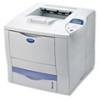Brother International HL-7050N Network Users Manual - English - Page 132
Configuring the IP Address with DEC NCP or BRCONFIG, Q-BUS systems, SVA-0 for DEC workstations
 |
UPC - 012502603375
View all Brother International HL-7050N manuals
Add to My Manuals
Save this manual to your list of manuals |
Page 132 highlights
Certain BOOTP host software implementations will not respond to BOOTP requests if you have not included a download filename in the configuration file; if this is the case, simply create a null file on the host and specify the name of this file and its path in the configuration file. As with rarp, the print server will load its IP address from the BOOTP server when the printer is powered on. Configuring the IP Address with DEC NCP or BRCONFIG Users of DEC and Novell networks have additional alternatives for configuring the IP address of Brother print servers by using the remote console facility. On VMS systems, you will need to have DECNET running in order to use the remote console. The procedure of DEC Network is as follows: Connect to the remote console, if you are using the remote console with VMS or LTRIX, you will need to know the circuit ID *QNA-0 for Q-BUS systems, SVA-0 for DEC workstations, UNA-0 for UNIBUS systems, BNA-0 for BI systems, and MNA-0 for XMI systems; you can get the circuit ID by executing the VMS NCP command SHOW KNOWN CIRCUITS) and the Ethernet address of the print server (which you can get either from the label on the print server or via the printer configuration page). To do this on a printer that has an LCD panel: take the printer off-line by pressing the SEL button, press and hold down the SHIFT button then press the UP arrow button until PRINT CONFIG is displayed on the printer's LCD, press the SET button. The printer will then print out a configuration page. The sheet labeled "Print Configuration" contains all print server configuration information. Put the printer back on-line again by pressing the SEL button. For internal print servers that are connected to a Brother printer which does not have an LCD panel, refer to the Quick Setup Guide for information on how to print out a configuration page. Brother's external interfaces, which connect to the parallel interface, have a black button recessed into the rear of the unit. Press this button to print out a configuration page. TCP/IP CONFIGURATION 12 - 9















